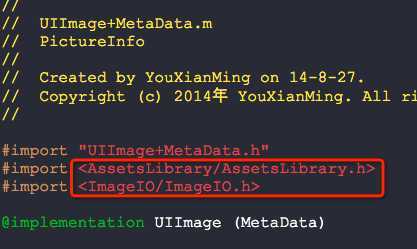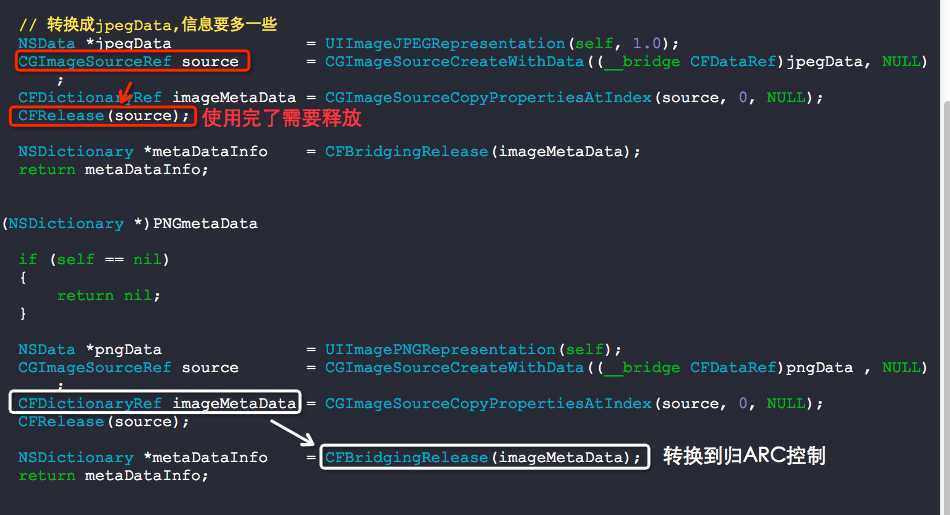Interesting question! I came up with the following solution working
for images picked from your photo library (note my code is using ARC):
Import AssetsLibrary.framework and ImageIO.framework.
Then include the needed classes inside your .h-file:
#import <AssetsLibrary/ALAsset.h>
#import <AssetsLibrary/ALAssetRepresentation.h>
#import <ImageIO/CGImageSource.h>
#import <ImageIO/CGImageProperties.h>
And put this inside your imagePickerController:didFinishPickingMediaWithInfo: delegate method:
ALAssetsLibrary *library = [[ALAssetsLibrary alloc] init];
[library assetForURL:[info objectForKey:UIImagePickerControllerReferenceURL]
resultBlock:^(ALAsset *asset) {
ALAssetRepresentation *image_representation = [asset defaultRepresentation];
// create a buffer to hold image data
uint8_t *buffer = (Byte*)malloc(image_representation.size);
NSUInteger length = [image_representation getBytes:buffer fromOffset: 0.0 length:image_representation.size error:nil];
if (length != 0) {
// buffer -> NSData object; free buffer afterwards
NSData *adata = [[NSData alloc] initWithBytesNoCopy:buffer length:image_representation.size freeWhenDone:YES];
// identify image type (jpeg, png, RAW file, ...) using UTI hint
NSDictionary* sourceOptionsDict = [NSDictionary dictionaryWithObjectsAndKeys:(id)[image_representation UTI] ,kCGImageSourceTypeIdentifierHint,nil];
// create CGImageSource with NSData
CGImageSourceRef sourceRef = CGImageSourceCreateWithData((__bridge CFDataRef) adata, (__bridge CFDictionaryRef) sourceOptionsDict);
// get imagePropertiesDictionary
CFDictionaryRef imagePropertiesDictionary;
imagePropertiesDictionary = CGImageSourceCopyPropertiesAtIndex(sourceRef,0, NULL);
// get exif data
CFDictionaryRef exif = (CFDictionaryRef)CFDictionaryGetValue(imagePropertiesDictionary, kCGImagePropertyExifDictionary);
NSDictionary *exif_dict = (__bridge NSDictionary*)exif;
NSLog(@"exif_dict: %@",exif_dict);
// save image WITH meta data
NSString *documentsDirectory = [NSSearchPathForDirectoriesInDomains(NSDocumentDirectory, NSUserDomainMask, YES) objectAtIndex:0];
NSURL *fileURL = nil;
CGImageRef imageRef = CGImageSourceCreateImageAtIndex(sourceRef, 0, imagePropertiesDictionary);
if (![[sourceOptionsDict objectForKey:@"kCGImageSourceTypeIdentifierHint"] isEqualToString:@"public.tiff"])
{
fileURL = [NSURL fileURLWithPath:[NSString stringWithFormat:@"%@/%@.%@",
documentsDirectory,
@"myimage",
[[[sourceOptionsDict objectForKey:@"kCGImageSourceTypeIdentifierHint"] componentsSeparatedByString:@"."] objectAtIndex:1]
]];
CGImageDestinationRef dr = CGImageDestinationCreateWithURL ((__bridge CFURLRef)fileURL,
(__bridge CFStringRef)[sourceOptionsDict objectForKey:@"kCGImageSourceTypeIdentifierHint"],
1,
NULL
);
CGImageDestinationAddImage(dr, imageRef, imagePropertiesDictionary);
CGImageDestinationFinalize(dr);
CFRelease(dr);
}
else
{
NSLog(@"no valid kCGImageSourceTypeIdentifierHint found …");
}
// clean up
CFRelease(imageRef);
CFRelease(imagePropertiesDictionary);
CFRelease(sourceRef);
}
else {
NSLog(@"image_representation buffer length == 0");
}
}
failureBlock:^(NSError *error) {
NSLog(@"couldn‘t get asset: %@", error);
}
];
One thing I noticed is, that iOS will ask the user to allow location services – if he denies, you won‘t be abled to get the image data …
EDIT
Added code to save the image including its meta data. It‘s a quick approach, so maybe there is a better way, but it works!









__bridgeis one of a hand full of keywords, which tell ARC about the objects ownership so it can properly clean them up. The simplest case is a__bridgecast, for which ARC will not do any extra work (it assumes you handle the object‘s memory yourself). – dom Mar 21 ‘12 at 6:45